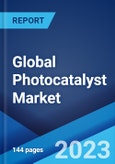The global photocatalyst market size reached US$ 2.4 Billion in 2022. Looking forward, the market is expected to reach US$ 3.9 Billion by 2028, exhibiting a growth rate (CAGR) of 8.43% during 2022-2028.
Photocatalyst is a substance that catalyzes the main reaction in photocatalysis. It absorbs light to bring it to a higher energy level and provides energy to a reacting substance, which results in a chemical reaction. It also destructs and degrades pollutants at ambient temperature and pressure compared to current air and water purification technologies. It is made using easily available materials, such as metal oxides, metal sulfides, oxysulfides, oxynitrides, and composites, and well-known techniques. As it is cost-efficient and consumes lesser energy, the demand for photocatalyst is escalating around the world.
Photocatalyst is a substance that catalyzes the main reaction in photocatalysis. It absorbs light to bring it to a higher energy level and provides energy to a reacting substance, which results in a chemical reaction. It also destructs and degrades pollutants at ambient temperature and pressure compared to current air and water purification technologies. It is made using easily available materials, such as metal oxides, metal sulfides, oxysulfides, oxynitrides, and composites, and well-known techniques. As it is cost-efficient and consumes lesser energy, the demand for photocatalyst is escalating around the world.
Photocatalyst Market Trends
There is currently a considerable scarcity of water on account of rapid industrialization and depleting freshwater resources worldwide. This represents one of the key factors impelling the market growth. Photocatalysts have superior chemical properties and the ability to decompose organic compounds that enhance the water treatment process. They are also environment friendly as they do not exhibit toxicity and absorb lamplight or sunlight for their functioning. Moreover, as they are made with self-cleaning materials and act as a barrier for dust and stains, photocatalysts are increasingly employed in the construction industry. This, along with the escalating demand for low volatile organic compounds (VOC) coatings and the expansion of the construction industry, is contributing to market growth. Furthermore, leading manufacturers are continuously investing in research and development (R&D) activities to introduce innovative photocatalysts materials using zinc oxide (ZnO) and calcium sulfide (CdS). This, in confluence with the increasing concerns about pollution, is positively influencing the adoption of these materials in the production of air conditioning systems, air filters, and ventilation. Besides this, the market is also driven by the growing applications of photocatalysts on glass surfaces, including glass film, optical lens, refrigerated showcase, road mirror, and bathroom or dresser mirror.Key Market Segmentation
This research provides an analysis of the key trends in each sub-segment of the global photocatalyst market report, along with forecasts at the global, regional and country level from 2023-2028. The report has categorized the market based on type, form and application.Breakup by Type:
- Titanium Dioxide
- Zinc Oxide
Breakup by Form:
- Powder
- Fines
- Sponge
- Bars/Blocks
- Granules
- Ingots
Breakup by Application:
- Self-Cleaning
- Air Purification
- Water Treatment
- Anti-Fogging
Breakup by Region:
- North America
- United States
- Canada
- Asia-Pacific
- China
- Japan
- India
- South Korea
- Australia
- Indonesia
- Europe
- Germany
- France
- United Kingdom
- Italy
- Spain
- Russia
- Latin America
- Brazil
- Mexico
- Middle East and Africa
Competitive Landscape
The competitive landscape of the industry has also been examined along with the profiles of the key players being Daicel Corporation, Ishihara Sangyo Kaisha Ltd, Japan Photocatalyst Center Co. Ltd., Kaltech Co. Ltd., Nanoptek Corporation, Sakai Chemical Industry Co Ltd, Showa Denko K. K., Souma Co. Ltd., Tayca Corporation, The Chemours Company, Toto Ltd. and Tronox Limited.Key Questions Answered in This Report:
- How has the global photocatalyst market performed so far and how will it perform in the coming years?
- What has been the impact of COVID-19 on the global photocatalyst market?
- What are the key regional markets?
- What is the breakup of the market based on the type?
- What is the breakup of the market based on the form?
- What is the breakup of the market based on the application?
- What are the various stages in the value chain of the industry?
- What are the key driving factors and challenges in the industry?
- What is the structure of the global photocatalyst market and who are the key players?
- What is the degree of competition in the industry?
Table of Contents
1 Preface3 Executive Summary11 Value Chain Analysis13 Price Analysis
2 Scope and Methodology
4 Introduction
5 Global Photocatalyst Market
6 Market Breakup by Type
7 Market Breakup by Form
8 Market Breakup by Application
9 Market Breakup by Region
10 SWOT Analysis
12 Porters Five Forces Analysis
14 Competitive Landscape
Companies Mentioned
- Daicel Corporation
- Ishihara Sangyo Kaisha Ltd
- Japan Photocatalyst Center Co. Ltd.
- Kaltech Co. Ltd.
- Nanoptek Corporation
- Sakai Chemical Industry Co Ltd
- Showa Denko K. K.
- Souma Co. Ltd.
- Tayca Corporation
- The Chemours Company
- Toto Ltd.
- Tronox Limited
Methodology

LOADING...
Table Information
| Report Attribute | Details |
|---|---|
| No. of Pages | 144 |
| Published | November 2023 |
| Forecast Period | 2022 - 2028 |
| Estimated Market Value ( USD | $ 2.4 Billion |
| Forecasted Market Value ( USD | $ 3.9 Billion |
| Compound Annual Growth Rate | 8.4% |
| Regions Covered | Global |
| No. of Companies Mentioned | 12 |









